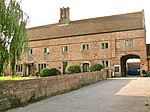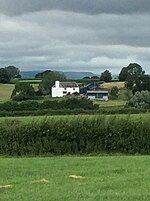Raglan, Monmouthshire
Communities in MonmouthshireMonmouthshire electoral wardsUse British English from January 2015Villages in Monmouthshire

Raglan (; (Welsh: Rhaglan) is a village and community in Monmouthshire, south east Wales, United Kingdom. It is located some 9 miles south-west of Monmouth, midway between Monmouth and Abergavenny on the A40 road very near to the junction with the A449 road. The fame of the village derives from Raglan Castle, built for William ap Thomas and now maintained by Cadw. The community includes the villages of Llandenny and Pen-y-clawdd. Raglan itself has a population of 1,183.
Excerpt from the Wikipedia article Raglan, Monmouthshire (License: CC BY-SA 3.0, Authors, Images).Raglan, Monmouthshire
Chepstow Road,
Geographical coordinates (GPS) Address Nearby Places Show on map
Geographical coordinates (GPS)
| Latitude | Longitude |
|---|---|
| N 51.7649 ° | E -2.85 ° |
Address
Chepstow Road
NP15 2EN , Raglan
Wales, United Kingdom
Open on Google Maps








